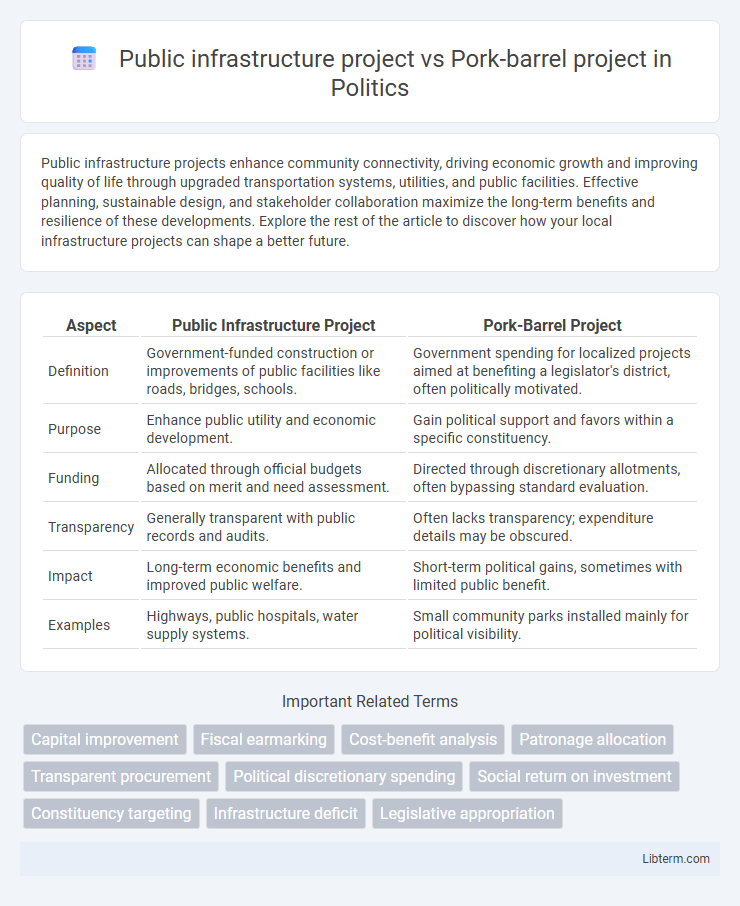Public infrastructure projects enhance community connectivity, driving economic growth and improving quality of life through upgraded transportation systems, utilities, and public facilities. Effective planning, sustainable design, and stakeholder collaboration maximize the long-term benefits and resilience of these developments. Explore the rest of the article to discover how your local infrastructure projects can shape a better future.
Table of Comparison
| Aspect | Public Infrastructure Project | Pork-Barrel Project |
|---|---|---|
| Definition | Government-funded construction or improvements of public facilities like roads, bridges, schools. | Government spending for localized projects aimed at benefiting a legislator's district, often politically motivated. |
| Purpose | Enhance public utility and economic development. | Gain political support and favors within a specific constituency. |
| Funding | Allocated through official budgets based on merit and need assessment. | Directed through discretionary allotments, often bypassing standard evaluation. |
| Transparency | Generally transparent with public records and audits. | Often lacks transparency; expenditure details may be obscured. |
| Impact | Long-term economic benefits and improved public welfare. | Short-term political gains, sometimes with limited public benefit. |
| Examples | Highways, public hospitals, water supply systems. | Small community parks installed mainly for political visibility. |
Definition of Public Infrastructure Project
Public infrastructure projects involve the development and maintenance of essential facilities and systems such as transportation networks, water supply, and energy grids that support economic growth and public welfare. These projects are typically funded by government budgets or public-private partnerships and aim to provide long-term benefits to the community. In contrast, pork-barrel projects refer to government spending on localized or politically motivated projects designed to win favor with specific constituencies rather than addressing broader public needs.
Definition of Pork-Barrel Project
Pork-barrel projects are government-funded initiatives aimed at benefiting a specific locality, often secured by legislators to gain political favor rather than addressing broader public needs. Unlike public infrastructure projects designed for widespread community development, pork-barrel spending typically involves earmarked funds for localized improvements that may lack transparency and strategic planning. This targeted allocation of resources can lead to inefficiencies and is criticized for promoting favoritism over equitable public investment.
Key Objectives and Purposes
Public infrastructure projects primarily aim to develop and maintain essential facilities such as roads, bridges, and utilities that promote economic growth and improve public welfare. Pork-barrel projects focus on securing government funds for localized initiatives that primarily benefit specific legislators' constituencies, often to gain political support. Both serve different objectives: infrastructure projects emphasize long-term public utility, while pork-barrel projects prioritize short-term political gains.
Funding Sources and Allocation
Public infrastructure projects receive funding primarily through government budgets, bonds, and public-private partnerships, ensuring allocations are based on strategic planning and long-term economic benefits. Pork-barrel projects rely heavily on discretionary spending by legislators, often funded by earmarked allocations within broader budgets, leading to localized benefits influenced by political considerations. The allocation of resources in public infrastructure projects emphasizes transparency and efficiency, while pork-barrel funding typically lacks stringent oversight, resulting in uneven distribution and potential misuse of public funds.
Community Impact and Public Benefit
Public infrastructure projects prioritize long-term community impact by providing essential services such as roads, schools, and hospitals that enhance public welfare and economic growth. Pork-barrel projects often funnel government funds into localized initiatives that benefit specific politicians' constituencies but may lack broader public utility and sustainable development. While public infrastructure projects aim for equitable resource distribution and inclusive progress, pork-barrel spending can undermine transparency and lead to inefficient allocation of resources.
Transparency and Accountability
Public infrastructure projects typically undergo rigorous scrutiny with established frameworks ensuring transparency and accountability through public bidding, performance audits, and stakeholder engagement. In contrast, pork-barrel projects often lack transparency, as funds are allocated based on political patronage rather than objective criteria, leading to reduced accountability and potential misuse of resources. Clear reporting mechanisms and independent oversight are essential to differentiate genuine public infrastructure initiatives from politically motivated pork-barrel spending.
Political Influence and Decision-Making
Public infrastructure projects are typically guided by technical assessments and long-term community benefits, whereas pork-barrel projects often stem from political influence aimed at securing votes or favor in specific districts. Decision-making in public infrastructure relies on transparent planning and budget allocation processes, while pork-barrel projects reflect strategic political bargaining and discretionary funding. The divergence highlights how electoral incentives can skew resource distribution away from broader public interest toward targeted political gains.
Economic Efficiency and Sustainability
Public infrastructure projects prioritize long-term economic efficiency by addressing critical needs such as transportation, utilities, and public services, thereby promoting sustained economic growth and environmental sustainability. Pork-barrel projects often focus on localized, short-term gains driven by political interests, which can lead to inefficient allocation of resources and limited positive impact on broader economic development or sustainability goals. Investing in public infrastructure enhances overall productivity and environmental resilience, while pork-barrel spending risks inflating costs without delivering meaningful economic or sustainable benefits.
Case Studies: Successful and Controversial Projects
The Big Dig in Boston highlights a successful public infrastructure project that transformed urban traffic flow and reduced congestion through extensive tunneling and highway realignment. Conversely, the Philippines' Priority Development Assistance Fund (PDAF) scandal exemplifies a controversial pork-barrel project, where misallocation of public funds led to corruption and loss of public trust. These case studies illustrate the stark contrast between transparent, well-managed projects that enhance public welfare and those plagued by misuse of funds and political patronage.
Strategies to Prevent Pork-Barrel Practices
Implementing transparent budgeting and strict auditing mechanisms significantly reduces opportunities for pork-barrel projects by ensuring public infrastructure funds are allocated based on merit and public need. Establishing independent oversight bodies and enforcing legal consequences for misuse of funds deter legislators from diverting resources for personal or political gain. Engaging community stakeholders in project selection promotes accountability and prioritizes essential infrastructure improvements over politically motivated expenditures.
Public infrastructure project Infographic

 libterm.com
libterm.com